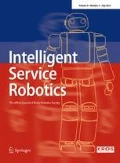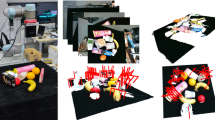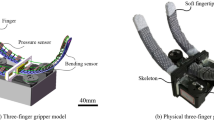Abstract
Service robots frequently operate various cylindrical objects with unknown physical properties, which demands the grippers of robots being equipped with force sensors to control grasp force. But force sensors are unnecessary and expensive for imprecise grasp force control for most operations in domestic environment. So as a substitute, this paper introduced the fuzzy hardness (FH) for imprecise grasp force evaluation. In addition, a method to infer the FH of objects was proposed, through vision and supervised learning. In this method, the deformation of objects related to the close degree of gripper was treated as a key variable and measured via visual methods. Based on the measured deformation data, long short-term memory network (LSTM) was introduced to conduct supervised learning synchronously. Then, several predicted deformation curves can be obtained through these LSTM blocks. Subsequently, the FH of objects would be clear when the errors between measured data and the predicted ones were calculated from the curves. The verification experiments showed that the maximum inference accuracy can reach 100% on TPU(80A) with 2 mm wall thickness. Moreover, after FH being applied, the deformation of TPU(80A) objects with 2 mm wall thickness decreased approximately 84.4% compared with using classical method. And all these results indicate that the FH inference method can be applied to adjust the grasp force for force sensor-less robots.











Similar content being viewed by others
References
Marton ZC, Balint-Benczedi F et al (2014) Part-based geometric categorization and object reconstruction in cluttered table-top scenes. J Intell Robot Syst 76(1):35–56
Marton ZC, Pangercic D, Blodow N et al (2011) Combined 2D–3D categorization and classification for multimodal perception systems. Int J Robot Res 30(11):1378–1402
Calli B, Walsman A, Singh A et al (2015) Benchmarking in manipulation research: using the Yale-CMU-Berkeley object and model set. IEEE Robot Autom Mag 22(3):36–52
Choi YS, Deyle T, Chen T et al (2009) A list of household objects for robotic retrieval prioritized by people with ALS. In: IEEE international conference on rehabilitation robotics, Kyoto, Japan, pp 510–517
Kapusta A, Kemp CC et al (2019) Task-centric optimization of configurations for assistive robots. Auton Robot 43:2033–2054
Ceccarelli M, Cafolla D, Carbone G et al (2017) HeritageBot service robot assisting in cultural heritage, general, and low-cost. In: IEEE international conference on robotic computing, Taichung, Taiwan (China), pp 440–445
Zhu H, Gupta A, Rajeswaran A et al (2019) Robot collisions: dexterous manipulation with deep reinforcement learning: efficient, general, and low-cost. IEEE ICRA, Montreal, Canada, pp 3651–3657
Ingrand F, Ghallab M (2017) Deliberation for autonomous robots: a survey. Artif Intell 247:10–44
Cafolla D, Wang M, Carbone G et al (2016) LARMbot: a new humanoid robot with parallel mechanisms. Springer, Cham, pp 275–283
Mahler J, Liang J, Niyaz S et al (2017) Dex-net 2.0: Deep learning to plan robust grasps with synthetic point clouds and analytic grasp metrics. arXiv preprint arXiv:1703.09312
Zheng Y (2018) Real-time contact force distribution using a polytope hierarchy in the grasp wrench set. Robot Auton Syst 99:97–109
Min JK, Ahn KH, Park HC et al (2019) A novel reactive-type joint torque sensor with high torsional stiffness for robot applications. Mechatronics 63:102265
Eguíluz AG, Rañó I, Coleman SA et al (2019) Reliable robotic handovers through tactile sensing. Auton Robot 43(7):1–15
Luo S, Mou W, Althoefer K et al (2019) Shape recognition by combining proprioception and touch sensing. Auton Robot 43(4):993–1004
Bohg J, Morales A, Asfour T et al (2013) Data-driven grasp synthesisa survey. IEEE Trans Robot 30(2):289–309
Mateo CM, Gil P, Torres F (2016) 3D visual data-driven spatiotemporal deformations for non-rigid object grasping using robot hands. Sensors 16(5):640–665
Seo J, Yim M, Kumar V (2016) A theory on grasping objects using effectors with curved contact surfaces and its application to whole-arm grasping. Int J Robot Res 35(9):1080–1102
Fakhari A, Keshmiri M, Kao I et al (2016) Slippage control in soft finger grasping and manipulation. Adv Robot 30(2):97–108
Shen X, Wang X, Tian M et al (2019) Modeling and sensorless force control of novel tendon-sheath artificial muscle based on hill muscle model. Mechatronics 62:102243
Bender J, Mller M, Otaduy MA et al (2014) A survey on position-based simulation methods in computer graphics. Comput Graph Forum 33(6):228–251
Steinemann D, Otaduy MA, Gross M (2008) Fast adaptive shape matching deformations. Proceedings of the 2008 ACM SIGGRAPH/Euro graphics symposium on computer animation, Dublin, Ireland, pp 87–94
Hwang W, Lim SC (2017) Inferring interaction force from visual information without using physical force sensors. Sensors 17(11):2455–2470
Wu J, Lu E, Kohli P et al (2017) Learning to see physics via visual de-animation. In: Advances in neural information processing systems, pp 152–163
Li SQ, Zhang S, Fu Y et al (2018) The grasping force control for force sensor-less robot through point clouds mask segmentation. ICRAE, Guangzhou, China, pp 1–4
Stachowsky M, Hummel T, Moussa M et al (2016) A slip detection and correction strategy for precision robot grasping. IEEE/ASME Trans Mechatron 21(5):2214–2226
Pyo Y, Nakashima K, Kuwahata S et al (2015) Service robot system with an informationally structured environment. Robot Auton Syst 74:148–165
Pham TH, Kyriazis N, Argyros AA et al (2017) Hand-object contact force estimation from markerless visual tracking. IEEE Trans Pattern Anal Mach Intell 40(12):2883–2896
Pham TH, Kyriazis N, Argyros AA et al (2015) Towards force sensing from vision: observing hand-object interactions to infer manipulation forces. In: Proceedings of the IEEE conference on computer vision and pattern recognition, Boston, USA, pp 2810–2819
Huang L, Yamada H, Ni T et al (2017) A masterCslave control method with gravity compensation for a hydraulic teleoperation construction robot. Adv Mech Eng 9(7):1–11
Wu Z, Song S, Khosla A et al (2015) 3d shapenets: a deep representation for volumetric shapes. In: Proceedings of the IEEE conference on computer vision and pattern recognition, Boston, USA, pp 1912–1920
Su H, Maji S, Kalogerakis E et al (2015) Multi-view convolutional neural networks for 3d shape recognition. In: Proceedings of the IEEE international conference on computer vision, Santiago, Chile, pp 945–953
Tamada T, Ikarashi W, Yoneyama D et al (2014) High-speed bipedal robot running using high-speed visual feedback. In: IEEE-RAS international conference on humanoid robots, Madrid, Spain, pp 140–145
Qi CR, Yi L, Su H et al (2017) Pointnet++: deep hierarchical feature learning on point sets in a metric space. In: The conference on neural information processing systems, organized by the neural information processing systems, Long Beach, USA, pp 1–10
Garcia-Garcia A, Gomez-Donoso F, Garcia-Rodriguez J et al (2016) Pointnet: a 3d convolutional neural network for real-time object class recognition. In: International joint conference on neural networks (IJCNN), Vancouver, Canada, pp 7815–1584
Sanchez J Corrales (2018) Robotic manipulation and sensing of deformable objects in domestic and industrial application: a survey. Int J Robot Res 37(7):1–29
Arriola-Rios Veronica EWyatt JL (2017) A multimodal model of object deformation under robotic pushing. IEEE Trans Cognit Dev Syst 9(2:153–169
Kampouris C, Mariolis I, Peleka G et al (2016) Multi-sensorial and explorative recognition of garments and their material properties in unconstrained environment. In: ICRA, Stockholm, Sweden, pp 1656–1663
Cretu AM et al (2012) Soft object deformation monitoring and learning for model-based robotic hand manipulation. IEEE Trans Syst Man Cybern B 42(3):740–753
Hu Z, Sun P, Pan J (2018) Three-dimensional deformable object manipulation using fast online Gaussian process regression. IEEE Robot Autom Lett 3(2):979–986
Yang B, Wang H, Chen W, et al (2016) Vision-based cutting control of deformable objects. In: IEEE international conference on real-time computing and robotics, Angkor Wat, Cambodia, pp 650–655
He K, Gkioxari G, Dollár P et al (2017) Mask R-CNN. In: IEEE international conference on computer vision, Venice, Italy, pp 2980–2988
Brie D, Bombardier V, Baeteman G et al (2016) Local surface sampling step estimation for extracting boundaries of planar point clouds. ISPRS J Photogramm Remote Sens 119:309–319
Demarsin K, Vanderstraeten D, Volodine T et al (2007) Detection of closed sharp edges in point clouds using normal estimation and graph theory. Comput Aided Des 39(4):276–283
Rusu RB, Cousins S (2011) 3d is here: point cloud library (pcl). In: IEEE international conference on robotics and automation, Miami, USA, pp 1–4
Hochreiter S, Schmidhuber J (1997) Long short-term memory. Neural Comput 9(8):1735–1780
Acknowledgements
We acknowledge the support received from the HUST & UBTECH Intelligent Service Robots Joint Lab and the National Nature Science Foundation of China (Grant No. 71771098).
Author information
Authors and Affiliations
Corresponding author
Additional information
Publisher's Note
Springer Nature remains neutral with regard to jurisdictional claims in published maps and institutional affiliations.
Rights and permissions
About this article
Cite this article
Li, S., Zhang, S., Fu, Y. et al. Grasp2Hardness: fuzzy hardness inference of cylindrical objects for grasp force adjustment of force sensor-less robots. Intel Serv Robotics 14, 129–141 (2021). https://doi.org/10.1007/s11370-021-00362-x
Received:
Accepted:
Published:
Issue Date:
DOI: https://doi.org/10.1007/s11370-021-00362-x




